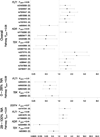Angiogenesis genes, dietary oxidative balance and breast cancer risk and progression: the Breast Cancer Health Disparities Study
- PMID: 23832257
- PMCID: PMC3830596
- DOI: 10.1002/ijc.28377
Angiogenesis genes, dietary oxidative balance and breast cancer risk and progression: the Breast Cancer Health Disparities Study
Abstract
Angiogenesis is essential for tumor development and progression. Genetic variation in angiogenesis-related genes may influence breast carcinogenesis. We evaluated dietary factors associated with oxidative balance, DDIT4 (one SNP), FLT1 (35 SNPs), HIF1A (four SNPs), KDR (19 SNPs), MPO (one SNP), NOS2A (15 SNPs), TEK (40 SNPs) and VEGFA (eight SNPs) and breast cancer risk among Hispanic (2,111 cases and 2,597 controls) and non-Hispanic white (1,481 cases and 1,586 controls) women in the Breast Cancer Health Disparities Study. Adaptive rank truncated product (ARTP) analysis was used to determine gene and pathway significance with breast cancer. TEK was associated with breast cancer overall (pARTP = 0.03) and with breast cancer survival (pARTP = 0.01). KDR was of borderline significance overall (pARTP = 0.07), although significantly associated with breast cancer in both low and intermediate Native American (NA) ancestry groups (pARTP = 0.02) and estrogen receptor (ER)+/progesterone receptor (PR)- tumor phenotype (pARTP = 0.008). Both VEGFA and NOS2A were associated with ER-/PR- tumor phenotype (pARTP = 0.01 and pARTP = 0.04, respectively). FLT1 was associated with breast cancer survival among those with low NA ancestry (pARTP = 0.009). With respect to diet, having a higher dietary oxidative balance score (DOBS) was significantly associated with lower breast cancer risk [odds ratio (OR) 0.74, 95% confidence interval (CI) 0.64-0.84], with the strongest associations observed for women with the highest NA ancestry (OR 0.44, 95% CI 0.30-0.65). We observed few interactions between DOBS and angiogenesis-related genes. Our data suggest that dietary factors and genetic variation in angiogenesis-related genes contribute to breast cancer carcinogenesis.
Keywords: FLT1; Hispanic; KDR; NOS2A; TEK; VEGFA; antioxidants; breast cancer; diet; survival.
© 2013 UICC.
Figures
Similar articles
-
SEPP1 influences breast cancer risk among women with greater native american ancestry: the breast cancer health disparities study.PLoS One. 2013 Nov 20;8(11):e80554. doi: 10.1371/journal.pone.0080554. eCollection 2013. PLoS One. 2013. PMID: 24278290 Free PMC article.
-
VEGFA, FLT1, KDR and colorectal cancer: assessment of disease risk, tumor molecular phenotype, and survival.Mol Carcinog. 2014 Feb;53 Suppl 1:E140-50. doi: 10.1002/mc.22058. Epub 2013 Jun 21. Mol Carcinog. 2014. PMID: 23794399 Clinical Trial.
-
Single nucleotide variants in metastasis-related genes are associated with breast cancer risk, by lymph node involvement and estrogen receptor status, in women with European and African ancestry.Mol Carcinog. 2017 Mar;56(3):1000-1009. doi: 10.1002/mc.22565. Epub 2016 Sep 21. Mol Carcinog. 2017. PMID: 27597141 Free PMC article.
-
Prognostic and predictive role of vascular endothelial growth factor polymorphisms in breast cancer.Pharmacogenomics. 2015 Jan;16(1):79-94. doi: 10.2217/pgs.14.148. Pharmacogenomics. 2015. PMID: 25560472 Review.
-
The role of vascular endothelial growth factor a polymorphisms in breast cancer.Int J Mol Sci. 2012 Nov 13;13(11):14845-64. doi: 10.3390/ijms131114845. Int J Mol Sci. 2012. PMID: 23203097 Free PMC article. Review.
Cited by
-
Genomic Disparities in Breast Cancer Among Latinas.Cancer Control. 2016 Oct;23(4):359-372. doi: 10.1177/107327481602300407. Cancer Control. 2016. PMID: 27842325 Free PMC article.
-
Association of dietary oxidative balance score and sleep duration with the risk of mortality: prospective study in a representative US population.Public Health Nutr. 2023 Oct;26(10):2066-2075. doi: 10.1017/S1368980023001155. Epub 2023 Jun 13. Public Health Nutr. 2023. PMID: 37309207 Free PMC article.
-
SEPP1 influences breast cancer risk among women with greater native american ancestry: the breast cancer health disparities study.PLoS One. 2013 Nov 20;8(11):e80554. doi: 10.1371/journal.pone.0080554. eCollection 2013. PLoS One. 2013. PMID: 24278290 Free PMC article.
-
The association between oxidative balance scores and all-cause mortality and cancer-specific mortality in cancer survivors: a retrospective cohort study.Front Nutr. 2025 May 21;12:1522048. doi: 10.3389/fnut.2025.1522048. eCollection 2025. Front Nutr. 2025. PMID: 40469679 Free PMC article.
-
Oxidative balance score and risk of cancer: a systematic review and meta-analysis of observational studies.BMC Cancer. 2023 Nov 24;23(1):1143. doi: 10.1186/s12885-023-11657-w. BMC Cancer. 2023. PMID: 38001409 Free PMC article.
References
-
- Prager GW, Poettler M. Angiogenesis in cancer. Basic mechanisms and therapeutic advances. Hamostaseologie. 2012;32(2):105–114. - PubMed
Publication types
MeSH terms
Substances
Grants and funding
- CA77305/CA/NCI NIH HHS/United States
- CA078682/CA/NCI NIH HHS/United States
- R01 CA078552/CA/NCI NIH HHS/United States
- HHSN261201000036C/CA/NCI NIH HHS/United States
- R01 CA078762/CA/NCI NIH HHS/United States
- R01 CA140002/CA/NCI NIH HHS/United States
- R01 CA063446/CA/NCI NIH HHS/United States
- CA078552/CA/NCI NIH HHS/United States
- CA078802/CA/NCI NIH HHS/United States
- U58 DP000807/DP/NCCDPHP CDC HHS/United States
- R01 CA078802/CA/NCI NIH HHS/United States
- R01 CA078682/CA/NCI NIH HHS/United States
- CA14002/CA/NCI NIH HHS/United States
- CA078762/CA/NCI NIH HHS/United States
LinkOut - more resources
Full Text Sources
Other Literature Sources
Medical
Research Materials
Miscellaneous


